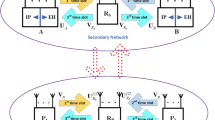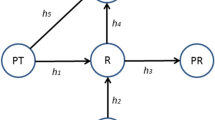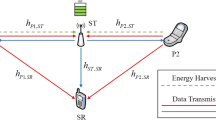Abstract
In this paper, the model of cooperative cognitive radio network is used to explore the two-way communications between a pair of unlicensed users by sharing the spectrum of any existing pair of licensed users. The licensed users of the spectrum are considered as primary users (PUs) and the unlicensed users of the spectrum are considered as secondary users (SUs). SUs are able to access the PUs spectrum by serving the relaying action between PU-to-PU communications. SUs are enabled by harvesting the energy from radio frequency signal following the principle of power splitting (PS) scheme of simultaneous wireless information and power transfer protocol. The closed form outage expressions of both PU and SU systems are derived. Analytical results validated through the simulations results. The results are also compared with existing work on two-way SU communications in presence of two-way PU communications. Based on the comparison, it is found that about \({\sim 191\%}\) and \({\sim 656\%}\) performance gains are possible to achieve by using proposed PS protocol in terms of spectrum efficiency and energy efficiency, respectively as compared to similar system using time switching protocol.





Similar content being viewed by others
References
Li, Y., Chi, K., Chen, H., Wang, Z., & Zhu, Y. (2018). Narrowband internet of things systems with opportunistic D2D communication. IEEE Internet of Things Journal, 5(3), 1474–1484.
Asadi, A., Wang, Q., & Mancuso, V. (2014). A survey on device-to-device communication in cellular networks. IEEE Communications Surveys & Tutorials, 16(4), 1801–1819.
Ansari, R. I., Chrysostomou, C., Hassan, S. A., Guizani, M., Mumtaz, S., Rodriguez, J., et al. (2018). 5G D2D networks: Techniques, challenges, and future prospects. IEEE Systems Journal, 12(4), 3970–3984.
Gandotra, P., & Jha, R. K. (2016). Device-to-device communication in cellular networks: A survey. Elsevier Journal of Network and Computer Applications, 71, 99–117.
Zhang, L., Liang, Y.-C., & Xiao, M. (2019). Spectrum sharing for internet of things: A survey. IEEE Wireless Communications Journal, 26(3), 132–139. https://doi.org/10.1109/MWC.2018.1800259.
Gandotra, P., Jha, R. K., & Jain, S. (2017). Green communication in next generation cellular networks: A survey. IEEE Access, 5, 11727–11758.
Cao, Y., Jiang, T., & Wang, C. (2015). Cooperative device-to-device communications in cellular networks. IEEE Wireless Communications, 22(3), 124–129.
Mustafa, H. A. U., Imran, M. A., Shakir, M. Z., Imran, A., & Tafazolli, R. (2016). Separation framework: An enabler for cooperative and D2D communication for future 5G networks. IEEE Communications Surveys & Tutorials, 18(1), 419–445.
Han, Y., Pandharipande, A., & Ting, S. H. (2009). Cooperative decode-and-forward relaying for secondary spectrum access. IEEE Transactions on Wireless Communications, 8(10), 4945–4950.
Luo, C., Min, G., Yu, F. R., Chen, M., Yang, L. T., & Leung, V. C. M. (2013). Energy-efficient distributed relay and power control in cognitive radio cooperative communications. IEEE Journal on Selected Areas in Communications, 31(11), 2442–2452.
Krikidis, I., Timotheou, S., Nikolaou, S., Zheng, G., Ng, D. W. K., & Schober, R. (2014). Simultaneous wireless information and power transfer in modern communication systems. IEEE Communications Magazine, 52(11), 104–110.
Nasir, A. A., Zhou, X., Durrani, S., & Kennedy, R. A. (2013). Relaying protocols for wireless energy harvesting and information processing. IEEE Transactions on Wireless Communications, 12(7), 3622–3636.
Ye, J., et al. (2017). Cooperative communications with wireless energy harvesting over Nakagami-m fading channels. IEEE Transactions on Communications, 65(12), 5149–5164.
Chatterjee, S., Maity, S. P., & Acharya, T. (2019). Energy-spectrum efficiency trade-off in energy harvesting cooperative cognitive radio networks. IEEE Transactions on Cognitive Communications and Networking, 5(2), 295–303.
El-Malek, A. H. A., Aboulhassan, M. A., & Abdou, M. A. (2020). Evolutionary computation technique enhancing the performance of cognitive radio networks with energy harvesting. Elsevier Journal of Ad Hoc Networks, 107, 102254.
Wang, S. -L., Chung, W. -H., & Wu, T. -M. (2018). Adaptive power and time usage energy harvesting in cognitive two-way relay networks. In Proceedings of IEEE wireless communications and networking conference (WCNC) (pp. 1–6), Barcelona, Spain.
Singh, S., Modem, S., & Prakriya, S. (2017). Optimization of cognitive two-way networks with energy harvesting relays. IEEE Communications Letters, 21(6), 1381–1384.
Mukherjee, A., Acharya, T., & Khandaker, M. R. A. (2018). Outage analysis for SWIPT-enabled two-way cognitive cooperative communications. IEEE Transactions on Vehicular Technology, 67(9), 9032–9036.
Li, Q., Zhang, Q., & Qin, J. (2016). Beamforming for information and energy cooperation in cognitive non-regenerative two-way relay networks. IEEE Transactions on Wireless Communications, 15(8), 5302–5313.
Gurjar, D. S., Nguyen, H. H., & Tuan, H. D. (2019). Wireless information and power transfer for IoT applications in overlay cognitive radio networks. IEEE Internet of Things Journal, 6(2), 3257–3270.
Ghosh, S., Acharya, T., & Maity, S. P. (2020). On outage analysis in SWIPT enabled bidirectional D2D communications using spectrum sharing in cellular networks. IEEE Transactions on Vehicular Technology, 69(9), 10167–10176.
Fragouli, C., Boudec, J. Y. L., & Widmer, J. (2006). Network coding: An instant primer. ACM SIGCOMM Computer Communication Review, 36(1), 63–68.
Gradshteyn, I. S., & Ryzhik, I. M. (2007). Table of integrals, series, and products (7th ed.). Cambridge: Academic Press.
Nadarajah, S. (2008). A review of results on sums of random variables. Acta Applicandae Mathematicae, 103, 131–140.
Author information
Authors and Affiliations
Corresponding author
Additional information
Publisher's Note
Springer Nature remains neutral with regard to jurisdictional claims in published maps and institutional affiliations.
Appendices
Appendix - A
1.1 Derivation of (24)
By using Taylor Series Expansion, it can be written as follows,
Appendix - B
1.1 Derivation of (28)
Let, \(X_u = (a_{si} X_{i1} +b_{si} X_{i2})\). Then the PDF of \(X_u\) is given by [24],
The solution of product of two random variables can be obtained as follows [23, Sec. 3.324.1, 3.471.9].
Rights and permissions
About this article
Cite this article
Ghosh, S. On spectrally-efficient device-to-device communication with wireless information and power transfer. Telecommun Syst 76, 569–578 (2021). https://doi.org/10.1007/s11235-020-00737-y
Accepted:
Published:
Issue Date:
DOI: https://doi.org/10.1007/s11235-020-00737-y




